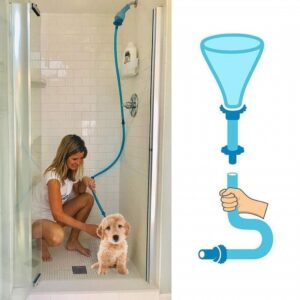As a doting dog owner and a woman with a heart full of love for my furry companion, this question constantly lingers in my mind: “Why does my dog lick me when I pet her?” It’s a mystery that holds the essence of our unique bond, and understanding it can bring us even closer to our beloved canines.
1. The Intriguing Question
This query is not just a passing thought. It’s a profound exploration into the world of canine behavior and the special relationship we share with our four-legged friends. Every time I run my hand through her soft fur and she responds with a gentle lick, I can’t help but wonder what lies behind this endearing action. Is it pure love and affection? Or is there a deeper meaning that we need to uncover? This question tugs at my heartstrings and prompts me to embark on a journey of discovery.
2. Natural Instincts and Scientific Basis
Licking is indeed a natural instinct for dogs. In the wild, puppies lick their mother’s face to stimulate the release of milk. This early behavior is deeply ingrained in their genetic makeup. From a scientific perspective, this action is related to the survival instincts of newborn puppies. The licking triggers a hormonal response in the mother, leading to the release of milk, which is essential for the puppies’ growth and survival.
In our domesticated settings, this instinct continues to manifest as a way of communicating and seeking attention. When my dog licks me while I’m petting her, it could very well be a sign of her deep affection and loyalty. Just as we might hug or kiss our loved ones, my dog uses licking as a physical expression of her emotional connection to me. It’s her way of saying, “I love you and I’m so happy to be with you.”
3. Sensory Exploration and the Science Behind It
Dogs are highly sensory creatures, and licking provides them with a wealth of information through taste and smell. The canine sense of smell is incredibly powerful, estimated to be tens of thousands of times more sensitive than that of humans. When my dog licks me, she is gathering information about my scent, mood, and overall well-being.
Scientists believe that dogs can detect changes in our body chemistry through smell. For example, if I’ve been outdoors or interacted with other people or animals, my dog may be trying to learn more about my recent experiences by licking me. This sensory exploration helps her build a better understanding of her environment and the people in it. It’s as if she’s conducting a little investigation, using her tongue as a tool to uncover the secrets of my day.

4. Communication Tool and Its Scientific Explanation
Dogs also use licking as a form of communication. Research has shown that dogs have a complex system of communication that includes body language, vocalizations, and physical contact. Licking can be a way for them to signal their needs or desires.
If my dog is hungry, thirsty, or wants to go for a walk, she might lick me as a way of getting my attention and making a request. Additionally, licking can be a sign of submission or appeasement. In a pack setting, dogs will often lick the more dominant members as a way of showing respect and deference. When my dog licks me while being petted, it could be an indication that she recognizes me as the leader and is seeking approval or reassurance.
5. Soothing Effect and Scientific Insights
Licking can have a soothing effect on dogs. From a scientific standpoint, the act of licking releases endorphins in a dog’s brain. Endorphins are chemicals that produce feelings of pleasure and relaxation. Just as humans might find comfort in hugging or holding a loved one, my dog may experience a sense of calm and relaxation when she licks.
If my dog is feeling nervous or stressed, she may turn to licking as a way to self-soothe. This is especially common in situations where she is exposed to new environments, loud noises, or unfamiliar people. The release of endorphins helps her cope with stress and anxiety, providing a natural way for her to find comfort.
6. Medical Considerations and Scientific Evidence
In some cases, excessive licking can also be a sign of an underlying medical issue. Skin conditions, ear infections, dental problems, and digestive issues can all cause a dog to lick more than usual. For example, if a dog has an itchy skin condition, they may lick the affected area to relieve the itch.
Scientists have found that certain medical conditions can lead to changes in a dog’s behavior, including excessive licking. If I notice a significant increase in my dog’s licking behavior or if it seems to be focused on a specific area, it is important to consult a veterinarian to rule out any potential health problems. Early detection and treatment of medical issues can not only improve my dog’s quality of life but also help address the excessive licking behavior.

7. Context Matters and Its Significance
It is also worth considering the context in which the licking occurs. For instance, if my dog licks me immediately after being scolded or punished, it could be a sign of seeking forgiveness or trying to diffuse a tense situation. On the other hand, if my dog licks me while playing or engaging in an activity, it may simply be an expression of excitement and enthusiasm.
Understanding the context can help me better interpret my dog’s behavior and respond appropriately. By paying attention to the circumstances surrounding the licking, I can gain insights into my dog’s emotional state and needs.
8. Ways to Help Reduce Excessive Licking
Now that we understand the reasons behind a dog’s licking behavior, let’s explore some ways to help reduce excessive licking.
8.1 Redirecting Attention
One effective method is redirecting your dog’s attention. When your dog starts licking you, immediately offer an alternative activity or toy. For example, you could give them a chew toy or start a game of fetch. This helps shift their focus away from licking and onto something more appropriate. According to scientific studies, dogs respond well to positive distractions, as it engages their minds and redirects their energy.
8.2 Training and Commands
Train your dog to respond to specific commands. Teach them a “stop” or “enough” command and reward them when they obey. Consistency is crucial here. Every time your dog starts licking, use the command firmly but calmly. Over time, they will learn to associate the command with stopping the licking behavior. Research has shown that positive reinforcement training can be highly effective in modifying a dog’s behavior.
8.3 Limit Physical Contact
If your dog tends to lick you a lot when you pet them, try limiting the physical contact initially. Pet them for shorter periods and then gradually increase the duration as they learn to control their licking. This helps them understand that excessive licking will result in less interaction. By setting boundaries in a gentle way, we can teach our dogs appropriate behavior.
8.4 Provide Mental Stimulation
Dogs that are bored or under-stimulated may resort to licking as a way to pass the time. Provide plenty of mental stimulation through puzzle toys, training sessions, or interactive games. This keeps their minds occupied and reduces the likelihood of excessive licking. Scientific studies have demonstrated that mental stimulation is essential for a dog’s well-being and can help prevent unwanted behaviors.
8.5 Address Underlying Issues
If you suspect that your dog’s licking is due to an underlying medical issue, such as pain, irritation, or an allergy, consult your veterinarian. Treating the underlying problem can often resolve the excessive licking behavior. Early diagnosis and treatment of medical conditions are crucial for a dog’s health and behavior.
8.6 Set Boundaries
Be consistent in setting boundaries for your dog. Let them know that licking is not always acceptable behavior. For example, you can gently push their head away or stand up and walk away when they start licking excessively. This sends a clear message that you won’t tolerate the behavior. Dogs respond well to clear boundaries and consistent discipline.
8.7 Positive Reinforcement
When your dog shows restraint and doesn’t lick, reward them with praise, treats, or affection. Positive reinforcement helps them understand what behaviors are desirable and encourages them to repeat those behaviors. Scientific research has shown that positive reinforcement is a powerful tool in shaping a dog’s behavior.
8.8 Stay Calm
Avoid reacting strongly or negatively when your dog licks you. Yelling or pushing them away harshly can sometimes make the behavior worse. Stay calm and use gentle redirection and training methods instead. A calm and patient approach is more likely to yield positive results.
8.9 Be Patient
Changing a dog’s behavior takes time and patience. Don’t expect immediate results. Keep working on it consistently, and over time, you should see a reduction in your dog’s licking habit. Understanding that behavior modification is a gradual process can help us stay committed and persistent.
In conclusion, when my dog licks me while I’m petting her, it can have multiple meanings. By understanding the natural instincts, sensory exploration, communication, soothing effect, and potential medical issues behind this behavior, we can better interpret our dog’s actions and respond appropriately. Additionally, by implementing the suggested methods to help reduce excessive licking, we can strengthen our bond with our furry friends and ensure their well-being. So, the next time my beloved dog licks me, I’ll take a moment to appreciate this unique form of communication and continue to work towards a harmonious relationship.




 Bathtub faucet spray accessories that don't require installation, super-flexible shower hoses - portable bathtub hoses.
Bathtub faucet spray accessories that don't require installation, super-flexible shower hoses - portable bathtub hoses.
您好,这是一条评论。若需要审核、编辑或删除评论,请访问仪表盘的评论界面。评论者头像来自 Gravatar。